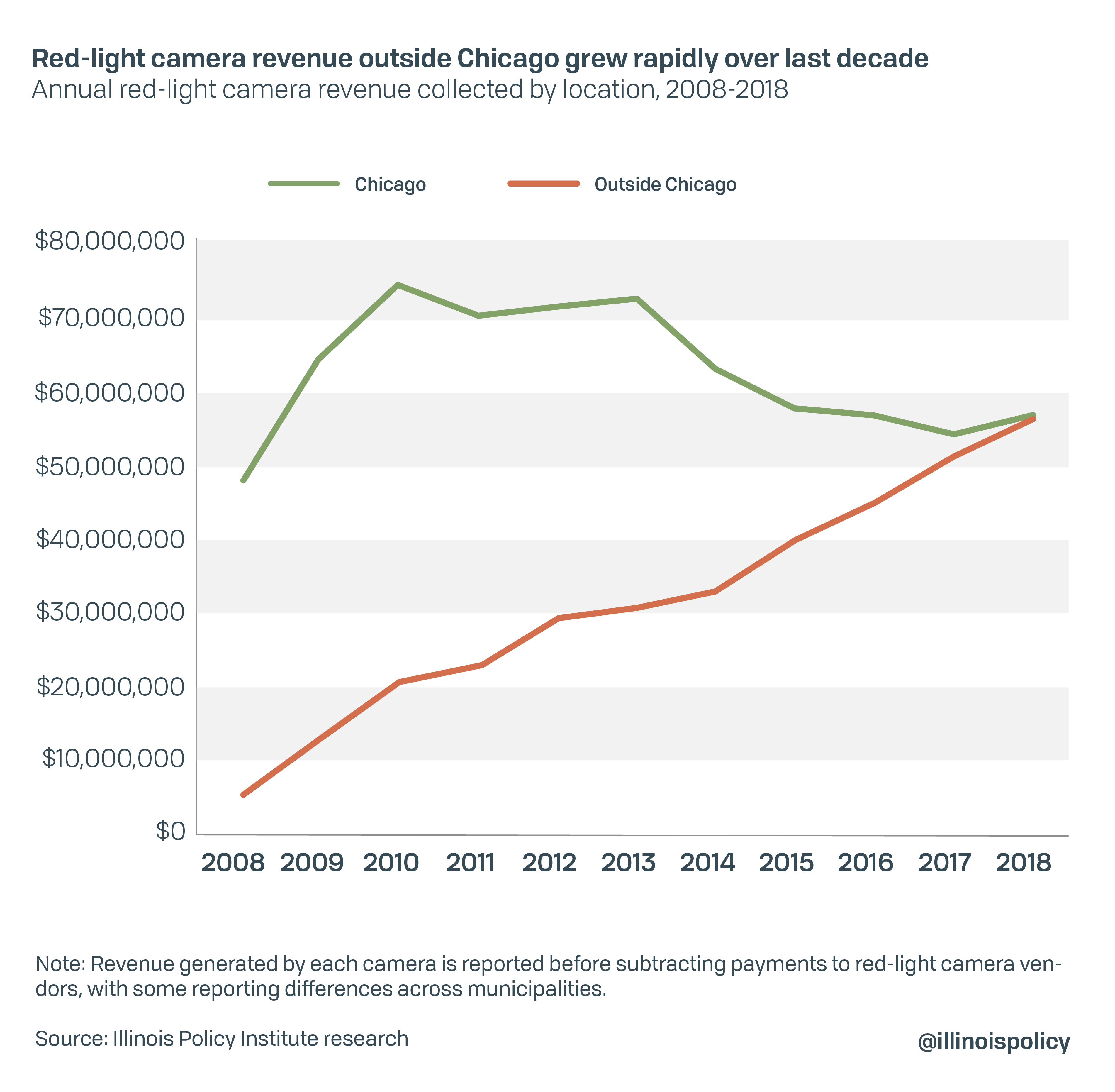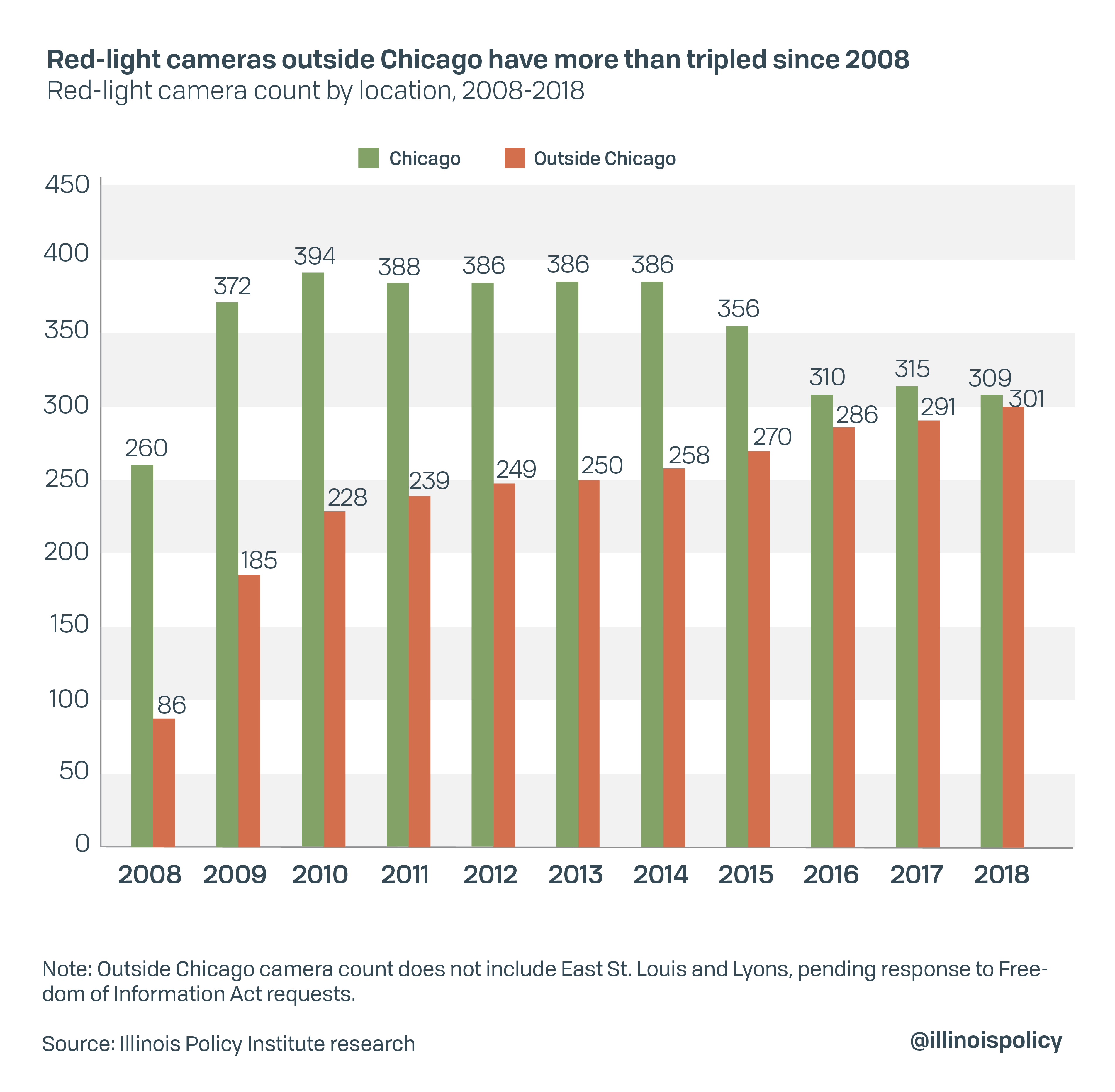Illinois local governments generated more than $1 billion in red-light camera revenue from 2008 to 2018, according to new analysis by the Illinois Policy Institute.
Each red-light camera ticket in Illinois costs drivers up to $100, depending on the municipality.
Chicago has long been a poster child for red-light camera abuse. The city is home to the nation’s highest count of red-light cameras, a former high-ranking transportation official serving jail time for taking bribes from a red-light camera company, and a pricey settlement for drivers who a judge ruled did not receive proper notifications in the ticketing process.
But the first-ever comprehensive look at red-light camera revenue across Illinois shows Chicago is far from alone.
In fact, when taken together, smaller local governments outside the city have installed almost as many red-light cameras as Chicago and collect nearly as much revenue. Further, federal investigations are raising questions of whether pay-to-play politics played a part in their proliferation.
Camera cash
The annual haul from red-light camera tickets statewide has more than doubled over the decade, with local governments collecting more than $113.2 million in 2018 compared with $53.5 million in 2008.
Red-light camera revenue outside Chicago city limits drove almost all of that increase, with $56.6 million generated in 2018 compared with $5.4 million in 2008.
These collection figures generally reflect what motorists paid in fines, as local governments reported red-light camera revenue before subtracting payments to companies that operate those cameras, with some slight reporting differences.
The number of cameras outside the city more than tripled from 2008-2018, to 301 from 86, nearly overtaking Chicago. At least 89 municipalities outside Chicago currently operate red-light camera programs.
To see the number of red-light cameras operated by each municipality, click here. To see the red-light camera revenue generated by each municipality, click here.
Although the number of cameras statewide has remained relatively flat since 2010, each camera on average is generating more revenue than ever. Revenue per camera in 2018 was more than $185,600, compared with less than $150,000 in 2014, when the number of red-light cameras in Illinois was at its highest.
Almost all red-light cameras in Illinois are confined to Chicago and its suburbs, save for Granite City in Madison County, which has been operating two cameras since 2010, generating over $1.6 million.
Red-light cameras in the Chicago suburbs have been a gold mine for local governments and a headache for drivers.
Well-traveled suburbs such as Elk Grove Village and Gurnee operate 10 and 15 cameras respectively. Southwest suburban Crestwood operates eight cameras, despite having only about 10,000 residents. Those Crestwood cameras have generated more than $13 million since coming online in 2016.
The three municipalities outside Chicago that have generated the most red-light camera tickets are Berwyn, Country Club Hills and Lakemoor:
- Berwyn generated $19.2 million from three cameras or less since 2009, the highest lifetime total of any municipality outside Chicago.
- Lakemoor positions three cameras at the busy intersection of IL Route 120 and US Route 12, which have generated $19.2 million since 2012.
- Country Club Hills generated $16.5 million with seven cameras since 2009.
Some suburbs continue to add new cameras to their existing collections. Alsip and Maywood have both added two cameras in recent years. Highland Park, Justice, Oakbrook Terrace and Wayne all installed their first red-light cameras over the last two years. Evergreen Park installed its first four cameras in 2018.
But not all suburbs have taken extra steps to squeeze money from drivers. Algonquin, Bolingbrook, Countryside, Geneva, Lake in the Hills, Naperville, and Warrenville have all removed their red-light cameras. Schaumburg removed its camera in 2009 after only nine months of operation, citing lack of improved safety at the intersection and backlash from the public.
Oakbrook Terrace is home to perhaps the most eye-popping numbers. Since installing two cameras in August 2017, the city of just over 2,000 residents has collected over $9.3 million before vendor payments. Oakbrook Terrace’s fiscal year 2019 revenue from red-light cameras was $5.4 million, far more than any other suburb. The city made more than one-third of its total revenue in fiscal year 2018 from red-light cameras, according to city budget documents. The city paid red-light company SafeSpeed LLC $1.5 million of the $3.8 million it collected from the cameras that year.
The story of how those cameras came to be points to an appearance of pay-to-play politics in Illinois’ red-light camera business.
Camera corruption
Oakbrook Terrace obtained its cameras after state Sen. Martin Sandoval, D-Chicago, lobbied the Illinois Department of Transportation, or IDOT, to allow SafeSpeed to operate cameras in the city, even though the need for a camera had dropped significantly, according to a 2017 Chicago Tribune report.
IDOT had previously rejected red-light camera requests from Oakbrook Terrace Mayor Tony Ragucci, for whom SafeSpeed has long been a top political donor. But the agency repeatedly found the intersections to be sufficiently safe. IDOT reversed its denial and approved the camera installations at Sandoval’s request, two months after the senator received a political contribution from SafeSpeed.
A year after IDOT reversed its decision on the Oakbrook Terrace cameras, Sandoval received the largest political donation in SafeSpeed’s history, $10,000. SafeSpeed investor Omar Maani gave Sandoval $5,000 around the same time, according to the Tribune, on top of a $10,000 contribution from SafeSpeed parent company Triad Consulting, where Maani is a principal.
Sandoval is just one red-light connection in a run of recent federal raids.
In September, a series of raids involving the FBI and IRS targeted Sandoval’s home and political offices, but also the village halls of Lyons, McCook and Summit. On Oct. 5, the Chicago Tribune reported federal agents were seeking information on SafeSpeed, “among other companies and individuals.” The search warrant for Sandoval’s office at the Illinois State Capitol revealed FBI agents were instructed to find numerous documents relating to SafeSpeed officials and red-light cameras.
SafeSpeed maintains a red-light camera contract with Summit, and employs as a consultant Patrick Doherty, the chief of staff for Cook County Commissioner Jeff Tobolski, who also serves as mayor of McCook. As a consultant, Doherty receives a percentage of the revenue from tickets issued through SafeSpeed in municipalities where he lands the company contracts.
More recently, federal authorities subpoenaed Worth Township Supervisor John O’Sullivan, a former state lawmaker who also works as a consultant for SafeSpeed, to give a deposition in a lawsuit against the neighboring village of Crestwood over its red-light camera program. Crestwood Mayor Lou Presta in August received $1,000 in political contributions from O’Sullivan’s consulting company, according to the Sun-Times.
Worth has operated four cameras since 2008, generating more than $5.6 million.
The Illinois Policy Institute confirmed the following municipalities contracted with SafeSpeed to operate red-light cameras, as of 2018: Summit, Matteson, Chicago Heights, Berwyn, Lakemoor, Hillside, Skokie, Westchester, Alsip, Oak Lawn, North Riverside, Country Club Hills, Crestwood, Tinley Park, Evergreen Park, Justice, Oakbrook Terrace and River Forest.
Authorities may find no wrongdoing in the spread of suburban red-light cameras. Regardless, the research is mixed at best regarding the cameras’ effects on traffic safety.
Safety dance
Red-light cameras in Illinois have done little to improve safety, but plenty to take more money from residents.
The 2017 Tribune report found over half of the intersections at which IDOT approved cameras were among the safest in the state, according to the department’s own study. Many permits were also given to intersections that had no red-light camera crashes in the previous three years.
Regardless of where they’re installed, red-light cameras lack clear-cut safety benefits. A 2018 study from Case Western Reserve University found red-light cameras likely do not increase traffic safety. Researchers looked at traffic accident data from Houston, which operated its red-light camera program from 2006 to 2010, and found that while T-bone collisions did indeed decrease during that time, non-angle collisions, such as rear-end crashes, actually increased. Moreover, rather than reducing traffic accidents, the study found that red-light enforcement cameras may have increased accidents overall.
A similar study by the Tribune in 2014 found the same results: rear-end crashes were up 22%. In some cases, the number of crashes at an intersection increased after the camera was installed. Many cameras in Chicago were also placed at intersections that already had few accidents.
Although a 2017 report paid for by the Chicago Department of Transportation recommended Chicago continue its red-light camera program, the university study’s less favorable findings follow that of other independent research on red-light camera programs.
Camera reform
As the body of research on the devices grows, communities across the country are increasingly deactivating their red-light cameras. Fewer than 350 communities nationwide were using red-light cameras as of October 2019, according to the Insurance Institute for Highway Safety. That’s a significant decrease from their peak in 2012, when around 540 communities operated red-light cameras.
But while Illinois has been slow to follow the nation’s hard turn away from red-light cameras, a recent push to ban the devices has found bipartisan support in the Statehouse.
In January, state Reps. David McSweeney, R-Barrington Hills, and Jonathan Carroll, D-Buffalo Grove, introduced House Bill 323, which would ban the use of red-light cameras statewide. On Oct. 4, state Reps. Rita Mayfield, D-Waukegan, and Sam Yingling, D-Grayslake, signed on as chief co-sponsors. On Oct. 7, state Reps. Grant Wehrli, R-Naperville, and Mark Batinick, R-Plainfield, introduced a separate proposal, House Bill 3909, which would restrict local governments’ ability to install the devices.
Texas Gov. Greg Abbott signed a bill in June 2019 to ban red-light cameras throughout the state, joining seven other states nationwide that prohibit using red-light cameras to cite drivers (Maine, New Hampshire, West Virginia, South Carolina, Montana, South Dakota and Mississippi), while another three states ban red-light cameras altogether, (Wisconsin, New Jersey and Arkansas), according to the National Conference of State Legislatures.
Red-light camera programs diminish trust in local government, and impose unfair financial burdens on residents subject to questionable ticketing practices.
Whether or not they’re proven to be part of the state’s culture of corruption, Illinois should bring red-light camera programs to a full stop.
Note: Through hundreds of Freedom of Information Act requests, the Illinois Policy Institute compiled every municipality believed to operate a red-light camera in the state, the number of red light cameras operate, and the revenue generated by year. The authors cannot guarantee every red-light camera in Illinois has been accounted for, as officials with the Illinois Department of Transportation confirmed the state does not keep a comprehensive list of municipalities that have installed red-light cameras. This report will be updated should any local governments report further red-light camera revenue. To report a municipality operating a red-light camera that does not appear on this list, email RLCs@illinoispolicy.org.
Illinois Policy Institute Intern Joe Barnas also contributed to this report.

